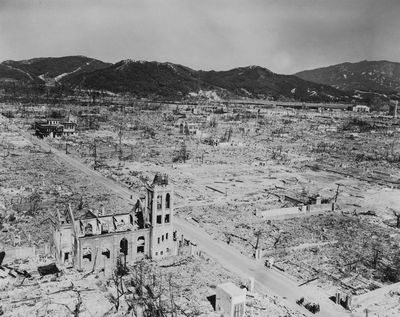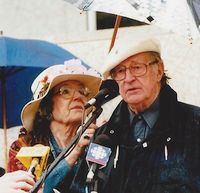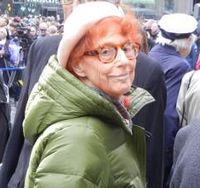Hiroshima-Nagasaki Day Coalition
Veterans Against Nuclear Arms (VANA) Memorial Pages
Comprehensive VANA History
(Much of the following text was written by Ed Shaffer as background information to Ernie Regehr’s policy paper, Nuclear Disarmament: An Action Agenda for Canada, Ploughshares Working Paper 07-1, May 2007. It has been updated by Anton Wagner, Audrey Tobias, Jordan Bishop, Phyllis Creighton, John and Betsy Bury, and other VANA members.)
Veterans Against Nuclear Arms (VANA) was formed in 1982 out of concern to the Canadian government’s decision to permit the testing in Canada of air-launched cruise missiles.
Alarmed by this development, four distinguished World War II veterans met in Halifax to protest against it. They were Dalhousie University faculty members C.G. “Giff” Gifford and Kell Antoft; Lloyd Shaw, a prominent Halifax businessman; and Hugh Taylor, the Nova Scotia provincial archivist. All served in the air forces during World War II. They called the organization Veterans for Multilateral Nuclear Disarmament (VMND) and set about to organize branches throughout the country. By 1987 they had established branches in Vancouver, Victoria, Nanaimo, Penticton, Edmonton, Saskatoon, Winnipeg, North Bay, Toronto, Ottawa, and Montréal. Two years later, the organization had several hundred members with 13 active branches in seven provinces.
In 1986 the organization’s name was changed to VANA. While its original focus was on nuclear weapons, it was later enlarged to oppose war in all forms. Veterans felt that an emphasis on nuclear weapons might give the impression that VANA favoured other types of weapons and that it was not opposed to other forms of war as a means of settling international disputes.
VANA’s goal was to ensure a secure future for the human race:
- by achieving common security for all nations;
- by finding non-military solutions for international conflicts;
- by establishing the rule of international law through the World Court;
- by joining with veterans and others world-wide to end the arms race;
- by working for the total abolition of nuclear weapons and war.
In 1985, the organization founded a non-profit corporation registered under the Companies Act of Nova Scotia, the Defence Research and Educational Centre Ltd., with charitable registration #BN 11922-9623-RR0001, to support its research and education activities. It was established to do research into and educate the public on issues of international relations and security, with particular reference to weapons of mass destruction. Its goal was to apply the understanding of war veterans and those closely affected by war to strengthening Canada’s contribution to peace.

Hiroshima, 1945
Ernie Regehr recalls Giff Gifford as a very effective, low-key spokesperson and founding leader of VANA who gained the confidence and respect of people, regardless of their political bent. Martin Duckworth’s documentary, Return to Dresden, recorded Gifford’s return visit to the city in 1985, when, in a tense moment, he met Dresden survivors and one of the German pilots face to face in a mission of peace. (The documentary is still available from the National Film Board, onf-nfb.gc.ca/en/our-collection/?idfilm=16170) Duckworth recalled that “Giff had founded VANA in response to Reagan’s preparations for a ‘limited nuclear war’ and the film may have helped VANA to become one of the most effective anti-war organizations in the Canadian peace movement.”
Inspired by Gifford, new VANA leaders sprang up throughout the country. Among them were Colonel Woody Coward and Colonel Norm Hoye in Vancouver; Peter Davies, Marion Frank, and Mark Frank in Toronto; Alan Phillips in Hamilton; Commodore Bob Cox in Halifax; and Major-General Leonard Johnson in Ottawa.
After many years in Halifax, the National VANA headquarters were moved to Vancouver in the early 1990s. Regional and national conferences featuring outstanding speakers were held in Winnipeg (1986), Halifax (1988), Toronto (1989), Vancouver (1990), Ottawa (1991), Edmonton (1992), PEI (1995), Toronto (1997), and Saskatoon (1998), where significant peace motions were adopted. Major VANA peace initiatives included the B.C. Nanoose Campaign to keep ships armed with nuclear missiles out of Nanoose Harbour; active opposition to low-level fighter bomber training over Innu territory in Labrador; and efforts to have Halifax declared a nuclear free port. In these and other campaigns, letters were sent to MPs, in their own language (French or English) addressed personally to each Member.
When the National Film Board released Brian McKenna’s documentary critical of the WWII firebombing of German cities, Death by Moonlight: Bomber Command, in 1991, there was a big reaction, which led to hearings by a Senate Committee the following year that was quite hostile to the film and its supporters. Giff Gifford had signed up to make a presentation to the committee, but when the hearings opened, he was too ill to come to Ottawa, so he sent his contribution to Jordan Bishop who read it to the Committee. (For Gifford's 1992 letters and Brief to the Senate Subcommittee on Veterans Affairs, see the Archives page on this website.)
Giff Gifford passed away on March 7, 1993. For Kell Antoft’s Peace Magazine obituary of Giff, see archive.peacemagazine.org/v09n3p31.htm.
During the Cold War, VANA arranged for visits with Soviet veterans and placed their grandchildren in each others’ summer camps. In Vancouver it participated in the annual Remembrance Day parades under a banner that read “Let Peace Be Their Memorial,” which always received an enthusiastic response from the onlookers. Members Woody Coward, Bas Robinson, and Art Laing spoke to school children under the auspices of the federal government’s “Memorial Project.”
VANA participated in the campaign to urge the nuclear powers to abandon their Launch-On-Warning policy. Under this policy, they will immediately launch missiles in response to a perceived nuclear attack. Since in the past there have been numerous false missile sightings, there is the possibility that a nuclear war, in which millions of people might be killed, could be triggered because of an error. This is why the movement to abolish nuclear weapons and war must be strengthened and why several VANA branches decided to work with Project Ploughshares to bring about a world without war.
VANA has achieved international recognition. The late Sir Joseph Rotblat and Dr. Hans Bethe, both Nobel Laureates, agreed to accept honorary membership in it. Other honorary members were Mordechai Vanunu, the Israeli peace activist; Dr. Helen Caldicott, founder of Physicians for Social Responsibility; and Cindy Sheehan, American peace activist.
Time, however, took its toll on VANA. Many of its members passed away or became less involved. Yet despite its declining membership, VANA remained active in the peace movement. Early in 2005, Ontario-Quebec Region member James Kafieh, former president of the Canadian Arab Federation, sent a letter, which was endorsed by national president David Morgan, to all Members of Parliament, urging them to vote against a proposal to participate in the United States Ballistic Missile Defense Program. Montréal member Alan Brown made arrangements to translate that letter into French. Their efforts, along with those of other peace organizations, paid off. Parliament turned down the proposal.
The Vancouver Branch, led by Ed Livingston, was an important member of the local Stop War coalition. After the national VANA office in Vancouver closed in 2009, only three functioning VANA groups remained. The ON-QUE Region, with Audrey Tobias as its dynamic coordinator until 2013, was an amalgamation of the VANA branches in Ontario and Quebec. Other active members in the region were Alan Brown in Montréal and Jordan Bishop in Ottawa. The Saskatoon Branch, led by John Bury and Betsy Bury, continued meeting with Project Ploughshares and playing a major role in the Saskatoon Peace Coalition. Betsy had organized the July 1998 Saskatoon National Convention with local VANA members at which most provinces were represented. In Vancouver, VANA member David Laskey continued to organize the annual Hiroshima and Nagasaki commemoration and to honour his wife, the Hiroshima survivor Kinuko Laskey. See the six-minute video Kinuko Laskey, Hiroshima Survivor www.youtube.com/watch?v=MYQrfwqx7zI and the Kinuko Memorial www.members.shaw.ca/kinukomemorial/kinuko_laskey.html.
Each local VANA chapter had its own leaders and peace history. Jordan Bishop, who moved to Ottawa in 1990, recalls that the presiding officer was the late Joe Levitt. This was a small group, ten or twelve members, and did not initiate any actions of any kind. The Ottawa VANA group deliberately saw themselves as involved with the larger peace movement, adding the voices of veterans of the armed forces to the larger contingent of peace groups in the Ottawa area. In demonstrations they carried the VANA banner up to the end. After Joe Levitt's death, Jordan Bishop assumed responsibility for the group, which continued to grow smaller. They were without exception veterans of the 1939-1945 war. There was at least one peace march in which Jordan carried one end of the banner and a non-VANA volunteer carried the other. The November 2006 list of Ontario-Quebec VANA members identifies from Ottawa: Jordan Bishop, Len Gelfand, Peter Hopwood, Walter Josephy (who had moved to Toronto by 2006. He took part in the regional VANA meeting at Orillia, ON, along with Jim MacDonald and Jordan Bishop), James Kafieh (Almonte, ON), Arnold Kerr (Almonte), Thomas Lumby, Jim MacDonald, John W. Patterson, Joe Piercy, Clyde Sanger, and Don Saxon. To this list we should add Joe Levitt, one of, or perhaps the, founder of the Ottawa group, which dissolved in 2014.
Since Saskatchewan contains two of the major world producers of uranium, it is not surprising that a small but active branch of VANA developed there. The public rejection of an uranium refinery in Warman in 1978 exposed a public distrust of the industry and government. In 1998 Saskatoon voted in a referendum that the city should be a nuclear weapons free zone. Cliff Matthews, Ben Smillie and Roy Pickford were early members but a formal branch did not form until late in the 1980s. At its height it had fifteen members including one German submariner and his wife. It was an active branch mounting many public events such as a protest against cruise missile testing and a Mothers’ Day picnic in the City Hall Square where branch members filled the gardens with cut-outs of peace Doves and reminded the public that Mothers’ day was a memorial to all those killed in the American Civil War. A regular stream of letters to the Star Phoenix maintained a reminder about the negotiations around the Nuclear Non-Proliferation Treaty, otherwise neglected as worthy of news coverage. Branch members were heavily involved in the World Court Project and were able to assist in collecting hundreds of Declarations of Conscience.

Betsy and John Bury in Saskatoon
The Saskatoon branch organised the 1998 VANA annual convention, with Commander Robert Green as the principal speaker. It was also remarkable in that the Doukhobor Choir took part in the proceedings, the first time they had ever worked in cooperation with veterans. Delegates were toured to the site of the last war in Canada at Batoche. The branch encouraged the City of Saskatoon to endorse Abolition 2000 and persuaded their mayor to become a Mayor for Peace. Although now reduced to three of the original VANA members, they remain active in partnership with Project Ploughshares in the Saskatoon Peace Coalition.
The Toronto VANA chapter emerged from meetings by veterans and peace activists such as Dave and Jean Wright, Joyce Sutherland and Barbara McKee at the Willowdale Newtonbrook United Church in 1985. That November, a “Pathways for Peace” meeting at Timothy Eaton Memorial Church featured Giff Gifford and Ursula Franklin. Gifford returned to Toronto in April of 1986 for a meeting at Trinity-St. Paul’s United Church, chaired by CBC broadcaster Bill McNeil, which led to the formal constitution of the Toronto VANA branch in May. Peter Davies served as the first chair of the Toronto group, followed for ten years by Marion Frank, two years by Dorothy Ross and Audrey Tobias until 2013. Activities by the Toronto chapter included the August Hiroshima Remembrance Day at Nathan Phillips Square; the Labour Day Parade to Exhibition Park in September; hosting the first Toronto showing of Return to Dresden in the Toronto City Council Chamber; and participating, wearing VANA’s white berets, in the annual Remembrance Day ceremony at the old City Hall Cenotaph. Marion Frank, who recalled a tremendous amount of anti-war sentiment in her generation, deposited a ten-year run of VANA newsletters, photographs and other archival materials at the City of Toronto Archives.
The Toronto chapter took part in peace marches, lobbied civic, federal and provincial officials to take stands for peace, published a newsletter, organized the 1997 national VANA conference at York University’s Glendon College, and invited speakers on major public issues. At its peak, it had about 130 members. Because more and more of its veterans in their 80s and 90s were dying of old age, the chapter supported a video oral history project in 2005-2006. Organized by Anton Wagner and filmed by Edimburgo Cabrera, it recorded the recollections and life experiences of 22 VANA members in Toronto and of 10 members from Vancouver and Saskatoon. Many excerpts from these interviews were included in Wagner’s 76-minute documentary Veterans Against Nuclear War. The film premiered at the World Peace Forum in Vancouver in 2006. It was also screened at the St. Andrews United Church, Toronto, and at the Evening of Peace, St. Andrew’s United Church, Wolfville, Nova Scotia, in 2006; at the Broadway Theatre, Saskatoon, and Canadian Federation of University Women, Toronto, in 2007; at Toronto City Hall and the Canadian Voice of Women for Peace AGM in Halifax in 2008; and at the Japanese Canadian Cultural Centre, Toronto, and Voice of Women Building Peace Making History Project, University of New Brunswick, in 2009.
Wagner and Phyllis Creighton were also active members of the Toronto Hiroshima Day Coalition, with Phyllis frequently serving as MC of its annual Hiroshima and Nagasaki Day Commemorations. They also helped to organize the lobbying campaign that persuaded Toronto City Council not to demolish the Peace Garden in front of City Hall.

Audrey Tobias, 2012
In 2013, Audrey Tobias’ acquittal in her court case for refusing to fill out the 2011 Canadian census because the government gave the contract to the U.S. war manufacturer Lockheed Martin, producer of cluster bombs, Trident missiles and the notorious F-35 fighter jets, garnered very positive TV and newspaper coverage from Toronto to Vancouver and as far as Australia. See for example this Toronto Star story from 23 January.
VANA’s archival records can be found at Library and Archives Canada and in university, provincial and civic archives where local chapters were located. Norman Hoye, chair of the VANA Lower Mainland B.C. Branch from 1985 to 1995, for example, donated the branches’ papers to the University of British Columbia. [A PDF of the finding aid of the VANA national papers up to 1992 at Library and Archives Canada can be downloaded here.]
Several years before its dissolution, VANA called on the federal government to create a Department of Peace, with a full cabinet-level minister in place alongside Foreign Affairs, whose mandate would be to focus on the rule of international law, the abolition of nuclear weapons, general disarmament, and peace-building. Unfortunately, the Conservative government refused to accept the proposal.
VANA members throughout Canada nevertheless can be proud of the fact that for thirty-two years they and their organization worked with other peace activists to call on the Canadian government to press for negotiations among the nuclear powers to greatly reduce and eventually eliminate all nuclear weapons.